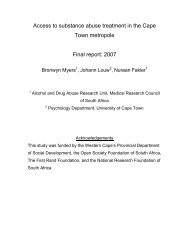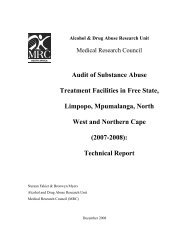Pan-African Conference 21 - 24 July 2002 Inter-Continental Hotel ...
Pan-African Conference 21 - 24 July 2002 Inter-Continental Hotel ...
Pan-African Conference 21 - 24 July 2002 Inter-Continental Hotel ...
Create successful ePaper yourself
Turn your PDF publications into a flip-book with our unique Google optimized e-Paper software.
Abstracts 10/22/02 11:26 AM Page 11<br />
stronger networks among academic trainers through the use of IT. Trainers get<br />
opportunities to use numerous available soft ware applications, test problem<br />
based learning, web-based distance training and web conferencing, discuss<br />
computer pedagogics and produce computer assisted learning materials. The<br />
lecture will raise key issues on IT in nutrition training in the South on the basis<br />
of experiences from the Global NutrITion programme.<br />
Information technology in nutrition research / La TI dans la recherche<br />
nutritionnelle<br />
Adelheid W. Onyango, PhD<br />
Department of Nutrition for Health and Development, World Health<br />
Organization, Geneva, Switzerland<br />
A research project advances in various stages, from formulating a hypothesis<br />
through designing the investigation, drawing a sample, collecting and<br />
analyzing data, writing up the research report to getting it published. IT is<br />
relevant to each of these stages of research.<br />
<strong>Inter</strong>est in a specific research question is often provoked by something one<br />
observes or reads about. The logical next step is to attempt an understanding<br />
of what is already known about the subject. Given the limited selection of print<br />
journals available in <strong>African</strong> universities and research institutions, IT can serve<br />
a pivotal role as a source of information. The occasional researcher can access<br />
a limited scope of scientific literature on the internet. However, individuals<br />
and institutions engaged in research have the option of subscribing to<br />
electronic scientific journals. In this respect, the recently launched internet<br />
initiative, “Access to Research” for developing countries is good news for<br />
biomedical researchers in Africa. The initiative makes more than two thousand<br />
journals available free or at significantly reduced charges to institutions<br />
in eligible countries (See Health <strong>Inter</strong>Network website:<br />
http://www.healthinternetwork.org).<br />
Once relevant literature has been reviewed, the hypothesis or research<br />
question formulated and a study design chosen, the researcher has to<br />
determine, adapt and refine methods and obtain study equipment if required.<br />
IT can be a useful search tool for contact addresses of researchers that one may<br />
wish to consult with and companies that supply the equipment required for<br />
the study (e.g., http://www.google.com).<br />
Data management and analysis require a computer, and with an internet link,<br />
one could download programmes for data management and analysis. A good<br />
example is Epi Info, a programme developed by the US Centers for Disease<br />
Control and Prevention, and available free of charge. This programme has<br />
modules for calculating sample size, designing a questionnaire that forms a<br />
template for data entry, can be set up to check consistency of data and includes<br />
some analysis routines. Epi Info should be of special interest to Nutrition<br />
researchers using anthropometry as it calculates anthropometric indicators for<br />
children and adolescents (http://www.cdc.gov/epiinfo).<br />
Research results need to be disseminated through publication, and many peer<br />
review journals now require electronic submission of manuscripts, a<br />
development that greatly speeds up correspondence with reviewers and<br />
editors, thanks to IT. In addition to print journals, it is now possible to publish<br />
in electronic research archives such as the one launched by the Lancet in 1999<br />
for purposes of publishing research that does not make it to the print journal<br />
but which is of interest to, for example, regional readership. Other outlets for<br />
research are databases maintained by United Nations agencies and others. The<br />
Department of Nutrition for Health and Development at WHO maintains six<br />
databases on different subjects in nutrition. The most widely used among<br />
them is the Global Database on Child Growth and Malnutrition<br />
(http://www.who.int/nutgrowthdb/).<br />
Although Africa is far behind the industrialized world in access to IT, a single<br />
internet connection in a given institution can facilitate access by thousands of<br />
researchers and students to information that has potential to change the<br />
quality of research and the efficiency and scale of its dissemination. The<br />
opportunities offered by IT are a capital challenge to every researcher on this<br />
continent to radically improve the quantity and quality of <strong>African</strong> research by<br />
<strong>African</strong> researchers.<br />
Food Composition Programme of AFROFOODS / Base de données sur la<br />
composition des aliments: AFROFOODS<br />
HC Schönfeldt and SM van Heerden*<br />
AFROFOODS coordinator, Centre for Nutrition, University of Pretoria, South<br />
Africa<br />
*Animal Nutrition and Animal Products Institute, Agricultural Research<br />
Council. Private Bag X2, Irene, South Africa<br />
ABSTRACTS<br />
During the <strong>African</strong> Food and Nutrition congress held in Harare, Zimbabwe in<br />
1988 the following problems were identified namely: Inadequate or complete<br />
lack of food composition tables in a number of <strong>African</strong> countries; incomplete<br />
and poor quality of available food composition data; lack of necessary<br />
equipment and human resources for food analysis activities; lack of<br />
coordination at regional and sub regional levels; lack of a forum for the<br />
exchange of information in the area of food composition. An <strong>African</strong> Network<br />
of Food Data System (AFROFOODS) as part of INFOODS (<strong>Inter</strong>national<br />
Network of Food Data Systems) was established in September 1994 in Ghana.<br />
This was followed by a meeting in Dakar (Ghana) during May 1995 during<br />
which activities was reestablished. Capacity building and training in<br />
analytical methods and compilation of food composition data were identified<br />
as a pre-requisite for progress during both meetings. During a workshop in<br />
Cape Town, South Africa (6-8 May 1996) a module on Food Composition and<br />
Hygiene for an M Sc in Food and Nutrition Sciences in developing countries<br />
for the Network of European Agricultural Universities (NATURA) - NECTAR<br />
group on as part of a EU-financed programme was drawn up. The module<br />
was based on the existing Food Composition Course of Wageningen<br />
Agricultural University and was first tested in South Africa during 1997 in<br />
Cape Town. The 1st ECSAFOODS course on the Production and Use of Food<br />
Composition Data in Nutrition was held from 23 June to 11 <strong>July</strong> 1997 at the<br />
University of the Western Cape, the 2nd ECSAFOODS course was held from<br />
5 – 27 June 1999 at the Agricultural Research Council (ARC) in Pretoria, South<br />
Africa. A third ECSAFOODS course will be held from 14 October <strong>2002</strong> to<br />
1 November <strong>2002</strong> in Pretoria, South Africa. AFROFOODS seem to lag behind<br />
other data centers with regard to the progress they have made during the same<br />
time period. Capacity building in the AFROFOODS region stays one of the<br />
mayor priorities for the immediate future, to equip people to assist their own<br />
countries in reaching the ultimate goal of being able to compile good quality<br />
food composition tables that reflect the individual food components in the diet<br />
of the different people within the country.<br />
IT an important tool in surveillance of food borne infections/intoxications<br />
and identification of contributing factors for outbreaks / La TI: un outil<br />
important dans la surveillance des infections et intoxications alimentaires et<br />
dans l’identification des facteurs contribuant aux épidémies<br />
Walter E.L. Spiess<br />
c/o Institut fuer Lebensmittelverfahrenstechnik, Universitaet Karlsruhe,<br />
Karlsruhe<br />
In the last decade the contamination of food with several dangerous<br />
pathogenic micro-organism has reached a dimension that it has to be<br />
considered as a serious health threat to the consumer. In order to deal<br />
successfully with this situation it is important to understand precisely the<br />
dimensions of the problem and the various causes of the problem.<br />
One of the prerequisites of a problem definition are national foodborne<br />
diseases surveillance systems on the basis of a mandatory notification of<br />
foodborne diseases outbreaks, surveillance data from national reference<br />
laboratories and e.g. national hospital networks. Besides the notification of<br />
cases of foodborne diseases, confirmed causative agents in foodborne<br />
outbreaks, incriminated foods and confirmed or suspected causative agents, as<br />
well as outbreaks by places where food was acquired or eaten and<br />
contributing factors have to be reported.<br />
Such surveillance systems require a rather complicated infrastructure which is<br />
based amongst others on a sophisticated IT system/Network.<br />
On the basis of individual national reports and the 7th Report of the WHO<br />
Surveillance Progamme for Control of Food borne Infections and Intoxication<br />
in Europe surveillance systems are presented and data obtained within the<br />
frame of such systems are discussed with respect of ensuring food safety and<br />
food hygiene.<br />
Hardware, software, people-ware in nutrition / Matériel, logiciel et<br />
ressources humaines en nutrition<br />
T Tylleskär<br />
Centre for <strong>Inter</strong>national Health, University of Bergen, Norway<br />
In the 70’s it was suggested that the ‘developing countries’ should not<br />
necessary follow the technological development of the so-called ‘western<br />
countries’. The idea of “appropriate technology” was widely supported in<br />
discussions on global development. Another thirty years of development has<br />
demonstrated that the technological advances are unifying all countries into<br />
the same technological development. Mobile phones could easily have been<br />
S11

















